How to Recruit During a Labor Shortage
In order to successfully overcome labor shortages and recruit top talent who intend to stick around, today’s companies must:
- Pay a competitive wage
- Get creative with recruitment
- Use the support from your current employees
- Use your job descriptions to show off your business
- Automate unnecessary tasks
- Allow for flexibility
- Improve your mental health-related benefits
Our recent study surveyed approximately 1,200 Americans to uncover more insights and solutions into employment trends currently gripping the nation.
- Chapter 1: What Is the Employee Shortage Crisis?
- Chapter 2: How Is the Worker Shortage Impacting Different Countries?
- Chapter 3: How is the Employee Shortage Impacting the Workforce?
- Chapter 4: Why Is There a Labor Shortage?
- Chapter 5: VidCruiter Survey: We Asked Americans – Are You Working? If Not, Why?
- Chapter 6: What Can Employers Do to Tackle the Employee Shortage?
- Chapter 7: The Worker Shortage Isn’t Going to Go Away Anytime Soon – But It’s Not All Bad News
Around the world, restaurants, retail stores, and hotels are unable to operate at full capacity. Global supply chain disruptions are resulting in out-of-stock items and sparse shelves. In late 2021, these scenarios aren’t due to COVID-19 public health restrictions or people hoarding supplies – a major employee shortage is causing breakdowns in service for many industries.
Walking through any city center, it’s common to see signs saying “hiring all positions” or “please be patient, we’re short-staffed” in restaurant and store windows, but still, positions remain unfilled. While this issue is particularly prevalent in lower-wage roles, there are employee shortages at every skill and salary level. Even Wall Street banks say they can’t hire enough people to meet their needs.
In the US, there are currently more than 10 million open jobs, the highest number ever. The number of job vacancies actually surpasses the number of unemployed Americans – there are over one million more unfilled positions than unemployed people.
Amount of open jobs
Amount of unemployed people

Who are the ‘unemployed’?
In America, people are classified as unemployed if they don’t have a job – they’ve actively been looking for work in the last 4 weeks and are currently available for work. There are many other people who are unemployed but aren’t available to work, such as people that are retired, in school, are unable to work due to an illness, and many other reasons. Since the mid 90s, less than 1 in 10 people that aren’t in the labor force have reported that they’re looking for a job.
So, why is there an employee shortage? And what can employers do about it? We’ve answered these questions and more in this article.
What Is the Employee Shortage Crisis?
An employee shortage crisis occurs when there are more open positions available than those available or willing to fill them. In turn, there is a high demand for workers. An employee shortage may also be referred to as a labor shortage or a worker shortage.
In April 2019, the US was celebrating the lowest unemployment of nearly 50 years. A year later, the unprecedented impact of COVID-19 meant the US economy lost 20.5 million workers in one month, sending the unemployment rate to 14.8% – the worst since the Great Depression. As we near the end of 2021, unemployment rates are still around 5%, which is still far higher than pre-covid times.
When the country reopened and people got vaccinated, many economists thought that people would be ready and willing to return to work. There have been many speculations about why there’s a labor shortage. In short, it’s due to a combination of driving forces that we’ll get into. What is clear though, is that there’s a disconnect between the unemployed and the work that’s available. It’s also clear that the job market will never be the same.
Before COVID-19, unemployment in the US reached a nearly 50-year low.
How Is the Worker Shortage Impacting Different Countries?
Truck driver shortage in the UK
The shortage has created a desperate need for truck drivers, with about 100,000 open positions. This has resulted in big supply chain issues such as frequently sparse supermarket shelves and restaurants without ingredients.
Small businesses struggling to hire in the US
In August 2021, 50% of small business owners said they had job openings they couldn’t fill – the most on record. Some business owners are increasing compensation to try to attract workers. In turn, these costs are being passed on to customers by raising prices for products and services.
Restaurants unable to fill positions in Canada
In July 2021, 80% of restaurants said they were struggling to hire back-of-house staff and 67% were struggling to hire front-of-house staff. Due to these shortages, restaurants around the country are cutting hours or even closing several days a week.
How Is the Employee Shortage Impacting the Workforce?
A survey by GetApp shows the challenges that businesses have faced this year due to a shortage of workers. In 2021, respondents said it’s been more common to experience delays in product deliveries, reduce operating hours, and even see a decline in product quality.
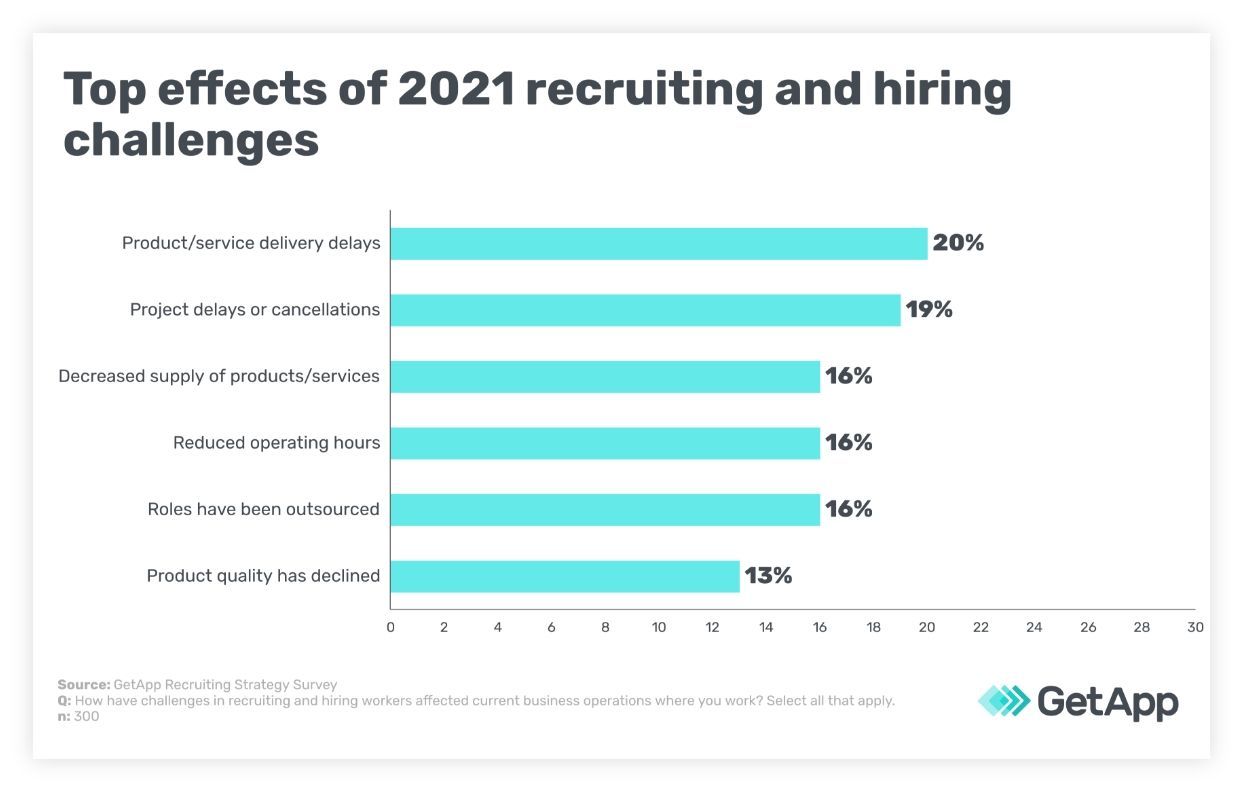
Why Is There a Labor Shortage?
The unemployed have never been so reluctant to find employment, but the labor shortage is mysterious in its origins. Researchers and economists believe that the following driving forces are attributed to the labor crunch:
Unemployment benefits are keeping the unemployed afloat
Some believe that the unemployed population doesn’t want to work because they’ve been making adequate money (for the meantime) on extended unemployment benefits. Under the Federal Pandemic Unemployment Compensation (FPUC), out-of-work Americans collected extra payments of initially $600, then $300 to recover lost wages – these benefits expired in September 2021. While they lasted, the extra money helped to ensure that most recipients would receive at least as much in unemployment benefits as they did from their recent employment.
There’s a belief that ending the additional payouts will push more workers back into jobs, but there are contrasting views of this. JPMorgan Chase report says the 26 states that cut off the benefits early didn’t gain any stronger job growth than the other states. Another report showed that only 6% of unemployment recipients will be motivated to go back to work when unemployment benefits end.
Fears over COVID-19
Among the unemployed, concern about COVID-19 is the most commonly cited reason for a lack of urgency when looking for in-person work, according to an Indeed survey.
It may come as a surprise considering vaccination rates continue to rise, but new variants of the virus keep causing the situation to change, and, in turn, people are increasingly wanting to stay home. Between August 2 and August 16, 3.2 million Americans told the Census Bureau that their reason for unemployment was due to concerns about the virus, up 30% from the previous two-week polling period.
Re-thinking what’s important
COVID-19 not only left many Americans jobless, but it disrupted the traditional work life for many others. The disruption of the regular work life has led many workers to shift or leave industries unexpectedly. This has contributed to a shortage of skilled workers to fill the positions that are now empty.
The pandemic has changed workers’ priorities. Resignations in the US workforce are the highest on record – up 13% from pre-pandemic levels.
Unemployed people had an opportunity to think about what matters for their career without the distraction of a 40-hour work week.
Employees that were forced to work from home realized they didn’t need to deal with long commutes to do their job – or many other jobs for that matter.
Older workers saw the benefits of retiring early to spend more time doing what they enjoyed, such as spending time with family.
Budding entrepreneurs, with more free time than before, had an opportunity to invest in their desire to start a business of their own.
An ability to ask for more
It’s becoming common practice for job-seekers to ask about things like wages before the first interview, or even cancel interviews because they have interviews with preferred companies. Due to the demand for workers, job seekers have found themselves in a position where they can ask for more – whether it be more money, better benefits, more flexibility or something else that’s important to them.
Similar to the research that states people are changing their career path or retiring unexpectedly, it seems that job seekers are finding work with other employers, leaving those job postings that don’t meet the requests of applicants with unfilled roles.
Childcare concerns
The childcare industry has struggled for a long time to find, hire, and retain employees, largely due to low wages and a lack of competitive benefits. The pandemic has since exacerbated the issue. The Bureau of Labor Statistics showed that the US childcare workforce is down 15% from pre-pandemic to mid-2021.
And, there is a second issue surrounding childcare – it’s an extremely expensive service. Many people using childcare services became unemployed during 2020 and didn’t have a stable income at the time. People are trying to re-enter the workforce, but many simply don’t have the savings to pay for childcare now.
The average cost of providing childcare for an infant in the US is $1,230 per month or $14,760 annually. This makes it more expensive than in-state college tuition in over half of the states.
A skill mismatch
Even before the pandemic, employers were sounding the alarm that jobseekers with key skills were in noticeably short supply. Factors such as a rise in automation and globalization were changing the way we work. The pandemic has sped up the changes, as businesses quickly had to find new ways to serve customers while working remotely. Now, there’s a mismatch between job openings in an industry versus how many unemployed people used to work in that industry pre-pandemic.
For example, the Department of Labor reported in June 2021 that there were 1.8 million job openings in professional and business services but only half as many people whose most recent job was in that sector.
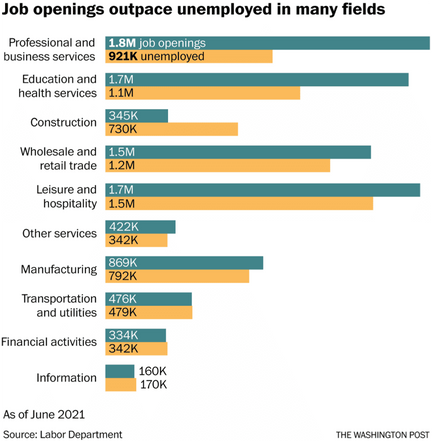
VidCruiter Asked Americans: Are You Working? If Not, Why?
There’s a lot of speculation and uncertainty on what’s behind the worker shortage. With this in mind, we decided to conduct our own research to see if there was anything else we could uncover about the shortage of employees. We surveyed nearly 1,200 Americans about their employment status and asked the unemployed population if they were looking for work.
What is the employment status of our respondents?
46% of respondents were in full-time or part-time employment. 36% are looking for work but are currently unemployed. 13% of respondents are not employed and not looking for work, and the last 5% are either retired or are unable to work for a particular reason.
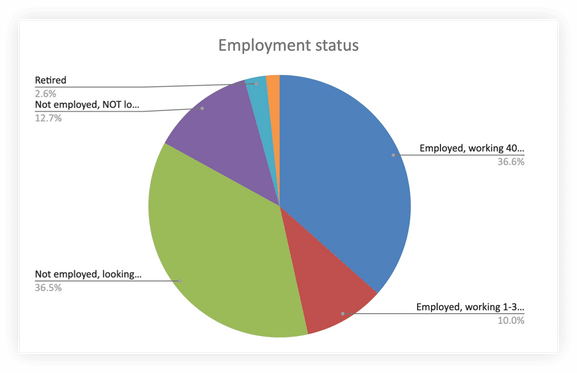
Why are unemployed Americans not looking for work?
We asked the 13% that are unemployed, ‘why’? Turns out, many of them have taken some time and figured out an alternative plan for themselves. Many are either going back to school, working for their own business, or earning a living from another method besides employment. This finding supports the reasons found in other research, that people are re-thinking what’s important to them during a time of disruption.
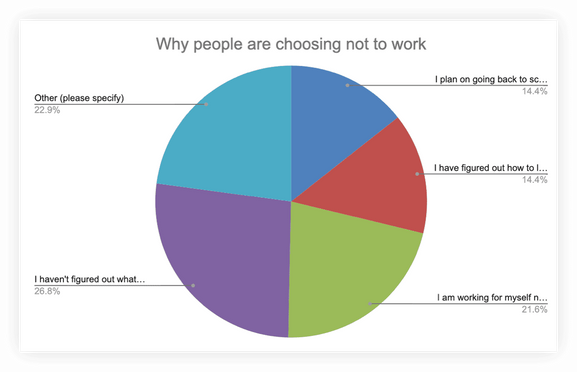
We asked the 23% that aren’t looking for work who responded “other” for more details. This is where our research got quite interesting. A whopping 43% of respondents said they were preoccupied with children for one reason or another. One respondent says “I am staying home with my 15-month-old son because we can no longer afford daycare” while another says “ I have 3 young kids. I really, really want to go back to work, but financially it doesn’t make sense. Daycare would cost more than what I would make.”
While a lot of research blames the unemployment benefits deterring Americans from working, only 3% of this group of respondents said that was why they weren’t working.
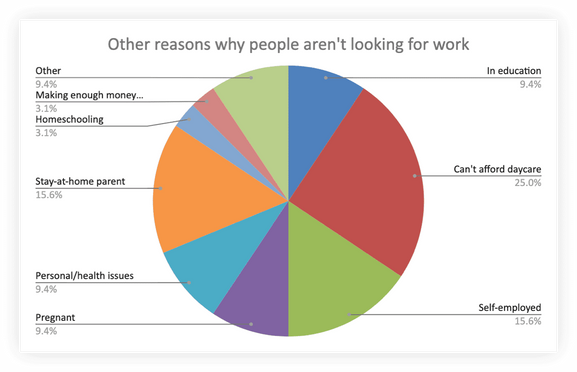
Is there a specific age group that isn’t looking for work?
We also wanted to see the breakdown of demographics that were not currently looking to work. Out of all of those who were unemployed, this shows the percentage of those that aren’t looking for work. While the results show quite a balanced mix, those between 35-54 were slightly less likely to look for work.
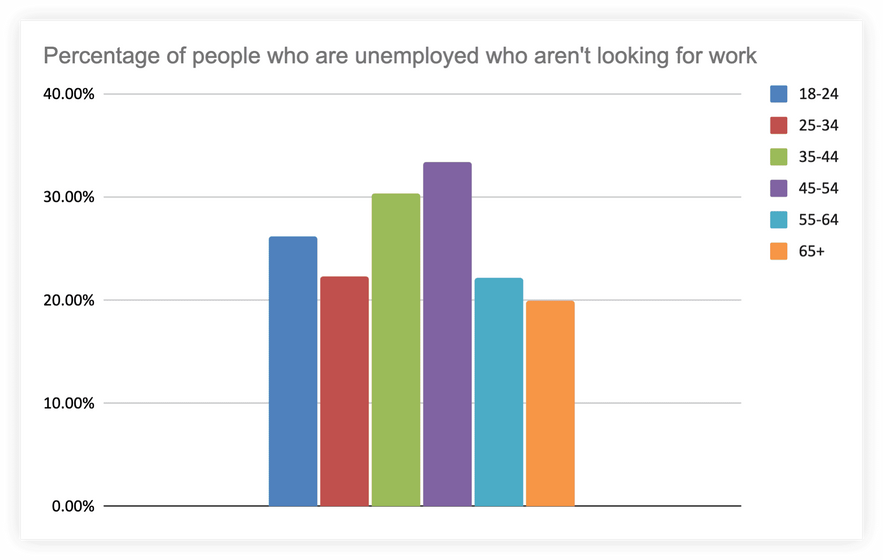
Unemployed 35-54-year-olds are less likely to be looking for work.
Are unemployed men and women equally looking for work?
Lastly, we explored whether there were any differences between women and men choosing not to work. We found that nearly one-third of women that are currently unemployed aren’t looking to work, compared to only one in five men that are unemployed.
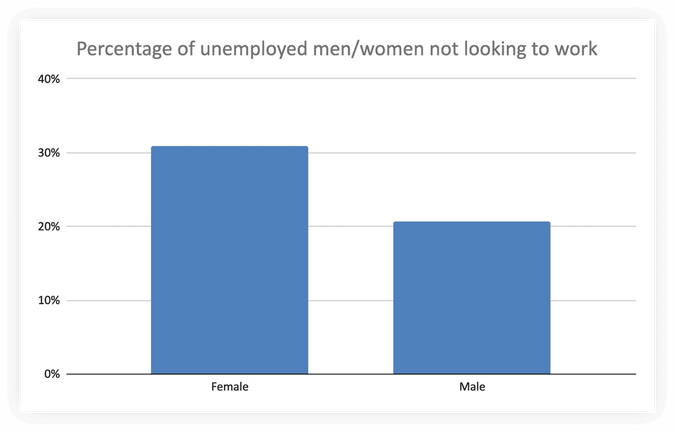
Nearly one-third of women that are currently unemployed aren’t looking to work, compared to only one in five men that are unemployed.
What Can Employers Do to Tackle the Employee Shortage?
The labor shortage we’re experiencing is real. Here are some of the top ways you can help the employee shortage crisis, and encourage quality hires, and retain current employees:
Pay a competitive wage
If you can afford to increase wages, consider it as one of your best chances to boost applicants – particularly for low-paid positions. In the last decade, there’s been a lot of talk about the minimum wage, which can be as low as $7.25. Many workers feel seriously underpaid and unable to adequately live off this amount of money.
Due to the demand for workers, applicants and employees currently have a bargaining power that they haven’t had in the past. They can negotiate better wages, or leave their current role for a higher-paying position. Many of America’s biggest employers have promised to increase their minimum wages or their average pay, including Target, Amazon, McDonald’s, Walmart, and Chipotle, paving the way for other companies to follow suit. Some of these companies are going a step further to impress job seekers by offering to pay for workers’ tuition and textbooks, too.
If you’re unable to increase wages, there are other ways you can attract applicants – all of our other tips don’t require a large investment to see results.

Get creative with recruitment
Right now, businesses need to get creative and go beyond the regular recruitment methods to be seen amongst the masses. Instead of simply recruiting through usual websites and platforms, promote job ads on social media, consider advertising through traditional print ads, or even try a really original way to recruit – there are many great examples online to look through.
Here are some creative ways other companies have sourced talent:
- McDonald’s teamed up with Snapchat and invited job-seekers to “try on” the uniform and send in a 10-second video application (or ’Snaplication’, if you will).
- Marriott has a “Marriot Careers” Instagram account where they post about their employees’ experiences and successes, along with frequent Instagram-worthy job postings and stories.
- Lowes Canada used a virtual recruitment event during the midst of the pandemic to allow 1000s of job-seekers to quickly and easily locate their nearest store and complete a pre-recorded video interview.
Use the support from your current employees
It’s no surprise that in the age when everything is accessible online, job-seekers can (and will) research your brand before applying for a position, especially while there are many positions available. Apparently, 86% of applicants are likely to research company reviews and ratings when deciding where to apply for a job. Moreover, candidates trust a company’s employees 3x more than a company itself to provide credible information on what it’s like to work there.
Ask your current employees to share their experiences. Frame it as a way for employees to provide their feedback and, in turn, help shape company initiatives and attract talent similar to themselves. On websites such as Glassdoor, feedback can be anonymous which helps ensure feedback is legitimate.
Negative reviews are often a reason companies shy away from asking employees to share feedback, but all feedback should be embraced as a learning experience – address negative feedback with a proactive response and amplify the positive comments with a thank you message. 62% of job seekers say their perception of a company improves after seeing an employer respond to a review.
Use your job descriptions to show off your business
Job descriptions often lack positives for the candidates – requirements can be unnecessarily high and there’s little description of what the applicant can get out of choosing to work for a company. It’s important to make your job descriptions stand out and positively market your workplace, especially while there’s so much competition.
Right now, candidates are looking for a positive company culture, so be sure to show off yours. In a recent survey, 37% of respondents felt that their company culture had improved since the pandemic. Play to your strengths by explaining employee perks and emphasis benefits you may have that could be a differentiating factor.
Automate unnecessary tasks
Currently, there are millions of low-paid job vacancies. Many unemployed Americans used to work long hours for low wages, and with time to step out of the industry, they won’t tolerate the conditions anymore.
Make sure you’re only asking candidates to do work that’s necessary, not extra tasks that could use simple technology to complete. For example, businesses can automate components of stock-checking, customer service, marketing, and recruiting. Options exist that don’t require a huge investment but could improve working conditions for your current and potential employees.
Allow for flexibility
Since the beginning of the pandemic, many Americans have experienced unpredictable events such as working from home while trying to homeschool or look after their children. In turn, many businesses created flexible work plans to allow their employees to work around unexpected situations.
A recent survey found that over half of employees would consider quitting their job after the pandemic if they weren’t offered enough flexibility on where and when they work. Be sure to emphasize a flexible schedule and the freedom to work from home if it’s possible with the role. Additionally, utilize tools that allow employees to work occasionally on the move with instant messaging, video conferencing, and other mobile-compatible products. This will allow employees to be productive while working around other tasks.
Even before employment, businesses can showcase their flexibility within the recruiting process. Tools such as pre-recorded video interviewing and allowing candidates to use interview scheduling software to schedule their own interviews could help to showcase the importance of flexibility within your workplace.
Improve your mental health-related benefits
If you’re in a good position to offer competitive benefits, you should certainly do so. A 2020 study showed that 32% of employers increased their mental health benefits in direct response to COVID-19. It was necessary to support their employees – in January 2021, 41% of adults reported feeling symptoms of depression or anxiety, up considerably from two years prior which indicated just 11% of adults experienced anxiety or depression.
Candidates can get a good idea of how important mental wellbeing is in the workplace – evidence is available in reviews from past employees, awards on your website, or benefits listed in your job description. If you’re unable to offer extended benefits, there are ways to promote mental wellness without the outright costs. Advocate for a positive work-life balance by offering mental-health days off and organizing social events. You can support employees’ mental wellness during the workday with mindfulness activities such as meditation, stretching, and breathing exercises, to name a few.
The Worker Shortage Isn’t Going to Go Away Anytime Soon – But It’s Not All Bad News
There are many factors contributing to the worker shortage, and, considering the scale of the issue, a fix isn’t simple. The good news is, the economy has already added millions of jobs this year (943,000 jobs in July 2021 alone), and the unemployment rate continues to fall.
But in many ways, this is an opportunity, not a crisis. There are steps that businesses can take to improve their chances of hiring quality candidates, by simply listening to what they want. In turn, making these adjustments will help to shape a better way of working for the future.
What recruiters are reading
Struggling with Interview Fatigue?
Yes, interview fatigue is a real thing. Back-to-back interviews are tiring and stressful. Here’s how to avoid it and regain enthusiasm for your job.

Types of Hiring Biases and How to Reduce Them
Hiring bias can be either conscious or unconscious, but either way, it’s bad for business. Bias leads to recruiters passing over high-potential candidates for lesser hires simply because of their own partiality.

VidCruiter Earns Great Place to Work® Certification
VidCruiter is proud to announce that we have been certified as a Great Place to Work® after a thorough, independent analysis conducted by Great Place to Work Institute® Canada.